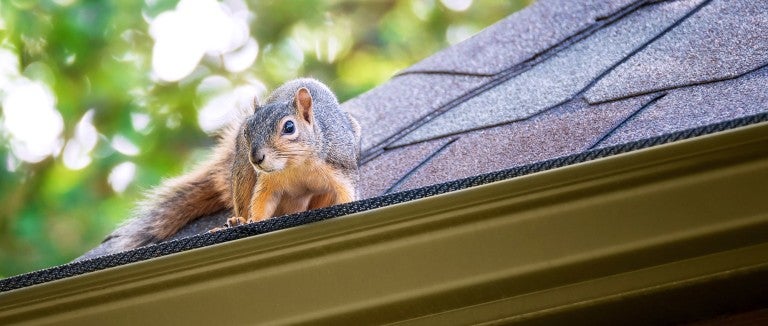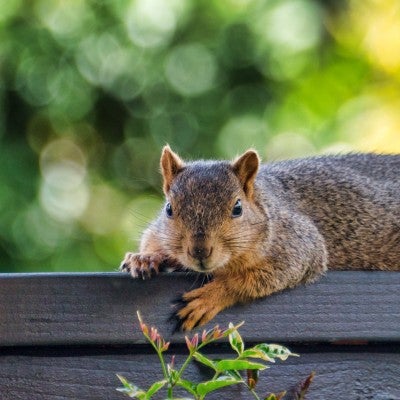Have you taken a good look at your house lately?
Do you know if you have deteriorated trim and fascia boards, holes in attic vents or an open chimney? While you may not be keeping close tabs on the condition of your house, you can bet the critters in your neighborhood are. It's recommended to assess the condition of your residence a couple of times a year to keep wildlife intrusions and other problems at bay.
Raccoons, skunks, squirrels and other animals may seek shelter in your chimney or attic or under your porch or deck. A few simple steps will keep unwelcome visitors out of your house. While you're getting your house ready for a change in the season, make sure it's wildlife-proofed as well.
Keep weather and wildlife outdoors
Openings into your house are not only attractive to animals, but they also allow heat to escape (thereby raising energy bills) and damaging moisture to enter. Combine your fall and spring exterior tasks like gutter cleaning, limb-trimming and weatherizing with a comprehensive inspection in which you view your house through the eyes of the wildlife around you. Are there cracks that an animal as small as a mouse might be able to squeeze though?
Don’t trap wildlife inside
Before closing, sealing or capping any potential entry points, make absolutely sure there are no animals already inside. Here’s how to avoid that problem: Plug suspect entry points loosely with insulation, paper or cloth that any animals who may be using the space inside can easily push aside. For a few days, check to see if the material has moved. If not, you can seal the opening.
Regardless of the season, it is always possible that babies or young could be present. Squirrels have two litters a year; one in early spring and one in late summer/early fall. Be careful not to separate mother from young; doing so can not only result in the inhumane death of the young, but can result in the mother tearing back into the spot where she was excluded from.
Before you begin, take a look at this house diagram [PDF] to help you locate potential problem areas. Now, you are ready to wildlife-proof your home.
Tools
- Binoculars to help see roof-level parts of your house like trim, siding and vents up close if climbing a ladder is not an option.
- A flashlight to see in the darker areas of your home.
- A camera to record what needs to be sealed and to help you monitor the condition of the exterior of your roof, trim and siding.
Foundation
- From the ground up, check the foundation for opening and signs of animal activity where pipes, vents and cables exit the house.
- Look where different types of building materials come together. Window wells, dryer exhaust vents, thresholds and gaps in brick or siding can all provide possible entryways.
- Holes smaller than a few inches can be caulked, stuffed with copper mesh or filled with expandable foam. Larger openings should be repaired to original condition.
Roof/siding/trim board
- From the outside or from a ladder, look for loose vent screens, roof holes and warped siding or trim board that is deteriorated and pulled away from the wall.
Attic
- Inspect attics with a flashlight for any signs of animals. Look for droppings, signs of chewing and nesting material.
- Pay attention to the intersection of roof and trim and any gable or exhaust vents. These are often covered with light bug screen that will not stand up to squirrels and raccoons.
- If a hole is found, assume an animal is present and never seal it up until you are completely sure that all animals are gone. Turn off attic lights and look for outside light leaking in, which will alert you to holes that could be potential entry points.
Test if an opening is being used by stuffing the hole loosely with a paper towel and waiting to see if it gets pushed in or out. If after three days of mild weather the paper stays in place, you can safely close the hole up. Be aware that animals might not come and go in severe weather or extreme cold and extend the time the test plug is left in under these conditions.
Use caulk for small holes, staple or screw hardware cloth over larger holes, or make permanent repairs. Bug screen (1/4 inch hardware cloth) will not hold up to stronger animals, such as raccoons. A 16-gauge 1x1-inch steel mesh is recommended for raccoons. For squirrels, solid aluminum flashing is the exclusion material of choice.
Use caution if bats may be present, as these animals won’t push through paper and can be difficult to see. They require a different type of inspection. Look carefully on the attic floor and on insulation for quarter-inch pellets that are a bit shiny and easily crumbled. You can also post a “bat watch” outside the house at dusk for a few evenings row to see if bats can be observed as they exit to forage. Call a bat removal specialist if you suspect these animals are using your attic.
Chimneys
- Check inside by shining a light up the flue, looking for animal signs on the damper and smoke shelf.
- Check the chimney flue from the roof (or have a chimney sweep do it) to make sure no animals are present.
- Once all is clear, install an animal-proof chimney cap.
Other tips
- Trash: Secure trash containers with cords, ropes or weights, or put trash out the morning of collection, not the night before.
- Trees/leaves: Keep branches trimmed six feet away from your house to not only limit access for wildlife, but to prevent damage to the roof that may allow animal entry in the future.
- Clean up debris; especially leaves piled in gutters and around the foundation.
- Compost: Cover and secure compost piles. Never compost meat scraps.

